RR Centauri
| Observation data Epoch J2000 Equinox J2000 | ||
|---|---|---|
| Constellation | Centaurus | |
| Right ascension | 14h 16m 57.22s[1] | |
| Declination | −57° 51′ 15.6″[1] | |
| Apparent magnitude (V) | 7.29[2] (7.27 - 7.68[3]) | |
| Characteristics | ||
| Spectral type | F0 V[4] | |
| U−B color index | +0.05[2] | |
| B−V color index | +0.36[2] | |
| Variable type | W Uma[3] | |
| Absolute magnitude (MV) | +1.882[4] | |
Inclination (i) | 81.00 ± 0.44° | |
| Details[7] | ||
| RR Cen1 | ||
| Mass | 1.82 ± 0.26 M☉ | |
| Radius | 2.1 ± 0.01 R☉ | |
| Luminosity | 8.89 L☉ | |
| Temperature | 6,912 K | |
| RR Cen2 | ||
| Mass | 0.38 ± 0.06 M☉ | |
| Radius | 1.05 ± 0.03 R☉ | |
| Luminosity | 2.2 L☉ | |
| Temperature | 6,891 ± 13 K | |
Cordoba Durchmusterung CD-57 5498[1] | ||
| Database references | ||
| SIMBAD | data | |
RR Centauri is a variable star of apparent magnitude maximum +7.29. It is located in the constellation of Centaurus, approximately 320 light years distant from the solar system.[6]
The system is a contact binary of the
The orbital period of this system is 0.6057 days (14.54 h). Calculations by astronomers from the Chinese Academy of Sciences show a possible cyclic variation in orbital period over 65.1±0.4 years whose amplitude is 0.0124±0.0007 d.[7] The origin of this periodic variation could be due to the gravitational influence of a third object yet observed. Superimposed on this variation seems to be a secular increase in the period of 1.21×10−7 d/a, suggesting that there is transfer of stellar mass from secondary to primary component. If this increase is confirmed, RR Centauri may evolve into a single rapidly rotating star.
References
- ^ a b c d "V* RR Cen -- Eclipsing binary of W UMa type (contact binary)". SIMBAD. Centre de Données astronomiques de Strasbourg. Retrieved 2016-02-27.
- ^ Bibcode:1979A&AS...38..355L.
- ^ Bibcode:2009yCat....102025S.
- ^ S2CID 15071352.
- S2CID 16274339.
- ^ S2CID 18759600.
- ^ .
- .

